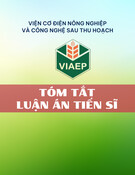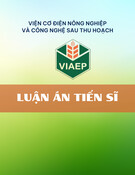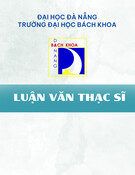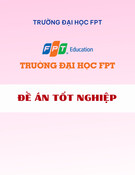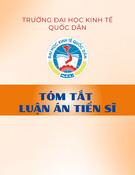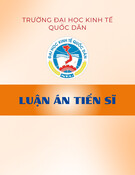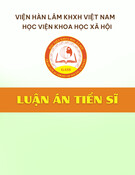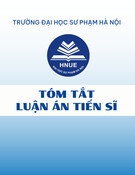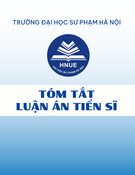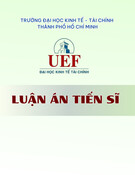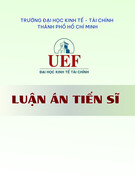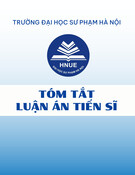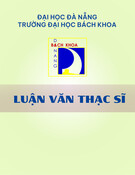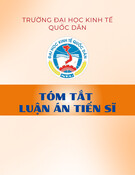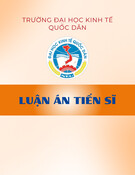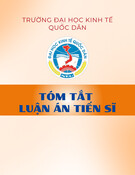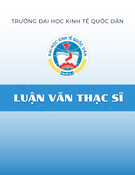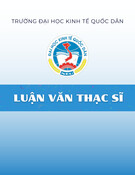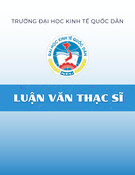CAN THO UNIVERSITY SCHOOL OF ECONOMICS AND BUSINESS ADMINISTRATION --- ---
NGUYEN TIEN DUNG SOLUTIONS TO ENHANCE THE ECONOMIC EFFICIENCY IN RICE PRODUCTION BY FARMING HOUSEHOLDS IN CAN THO CITY
SPECIALIZATION: AGRICULTURAL ECONOMICS CODE: 62 62 01 15
1
PH.D. DISSERTATION SUMMARY Can Tho, 2015
This dissertation is completed at Can Tho University
Supervisor: Dr. Le Khuong Ninh, Associate Professor
Discussant: Dr. Thai Anh Hoa
Discussant: Dr. Nguyen Phu Son, Associate Professor
This dissertation will be defended in the presence of a Ph.D. dissertation committee gathered at
on …
This dissertation is available at the Learning Resource Center of Can Tho University
2
Chapter 1
INTRODUCTION 1. Rationale
Agriculture, farmers and the rural sector play a stratgic role in the process of industrialization and modernization of Viet Nam. Therefore, good policies on those aspects is a key to the social – economic deveopment of the country. The Mekong River Delta (MRD) is one of the principal economic centrers of Viet Nam which provides more than 20 million tons of rough rice (accounting for as much 50% of rice supply and 90% of exported rice of the entire country). Located in the middle of the MRD, Can Tho city has significantly contributed to this achievement.
Can Tho city, which has more than 89,000 hectares of land devoted to rice production in triple cropping, produces more than 1 million of rough rice per year. In 2013, rice production of the city was of 1,370,354 tonnes (increasing by more than 2,8% as compared to that of 2012). However, the average income of the rural labour force (including rice-producing farmers) of the city was just of VND 25.8 million per year, equivalent to 41% of the average per capita income of the city (i.e., VND 62.72 millions). That has been a consequence of the fact that agriculture is much dependent on weather, instable input and output prices, a lack of agricultural insurance market, undeveloped infrastructure and a lack of investment capital. In addition, loose linkages between firms and farmers creates a chance for intermediaries (such as “rice brokers”) to benefit a lot from the profit created through the rice value chain in stead of farming households – those who have worked hard on producing rice.
As a tradition, farming households in Can Tho city do prefer quantity to quality, so a variety of grains have been cultivated. Therefore, the quality of the product (i.e., rice) varies a lot. Post-harvest services (such as purchasing, transporting and storage) are underveloped, creating much wastes and thus advese affecting the quality of rice. As a result, rice produced by Vietnam is hard to find way to high- income countries. This fact is the main reason why the economic efficiency in rice production by farming households is relatively low. Therefore, a study that aims to analyze the economic efficiency in rice production is important for policy makers, managers and farming households. Because of its central position in the MRD, Can Tho city has similarities with other provinces in the region, policies to raise economic efficiency in rice production by farming households in this city is also applicable to those in other procinces.
3
Economic efficiency in rice production has alurred economists for a long time and a number of sudies have been done on this topic, with the most prominent ones
being Theodore (1964), Rizzo (1979) and Ellis (1993). In Viet Nam, economic efficiency in rice production has also attracted atttention of many researchers. For the MRD in particular, such studies as Quan Minh Nhut (2006), Huynh Truong Huy et al. (2008), Pham Le Thong (2011) and Nguyen Huu Dang (2012) assert that economic efficiency in rice production in the MRD has been low and decreasing over time due to ununiformed techniques (reflecting in the non-technical efficiency) and poor skills in selecting inputs (reflecting in the non-allocative efficiency).
In order to better understand on the origin of those weaknesses, this dissertation enttiled “Solutions to enhance the economic efficiency in rice production by farming households in Can Tho city” is done so as to propose solutions to enhance the economic efficiency and income for rice producing ing households in Can Tho city in particular and the MRD in general.
1.2. Objectives
1.2.1. General objective
The general objective of this dissertation is to propose solutions to enhance the economic efficiency in rice production for farming households in Can Tho city using estimates on economic efficiency and its determinants.
1.2.2. Specific objectives
In order to obtain the general objective, this dissertation has the following specific objectives:
(i) Analyzing the status quo of production and trading of rice produced by farming households in Can Tho city.
(ii) Estimating the economic efficiency in rice production by farming households in Can Tho city.
(iii) Propoding solutions to enhance the economic efficiency in rice production for farming households in Can Tho city in particular and the MRD in general.
2.1.3. Content
Based on the above-mentioned objectives, this dissertation has the following contents:
(i) Summarizing studies on the topic published both inside and outside the country, which lay down a background for analyses and propositions of this dissertation.
4
(ii) Given the theoretical background on economic efficiency and empirical studies reviewed, this dissertation comes up with models to estimate the economic efficiency and its determinants for farming households in Can Tho City.
(iii) Given a data set on 815 farming households in Can Tho city, this dissertation proposes solutions to enhance the economic efficiency in rice production by farming households in Can Tho city.
1.3. Scope
1.3.1. Content
This disseration has the following contents:
- Systemizing theories on estimating economic efficiency and its determinants for rice farming households.
- Analyzing the status quo of production and trading of rice produced by farming households in Can Tho city, including issues on production technique, input market, output market and other relevant ones.
- Estimating the economic efficiency and analyzing its determinants for rice farming households in Can Tho city so as to propose solutions to enhance the economic efficiency in rice production by farming households in Can Tho city.
1.3.2. Aim
The aim of this dissertation is to study the economic efficiency in rice production by farming households in Can Tho city. This dissertation focuses on the status quo of rice production to figure out the determinants of the economic efficiency in rice production by farming households in Can Tho city so as to propose solutions to improve.
1.3.3. Location
Can Tho city has five urban districts and four rural ones. According to the city’s Depatment of Agriculture and Rural Development, rice production takes place mainly in four rural districts (i.e., Vinh Thanh, Co Do, Thoi Lai and Phong Dien). Those districts account for around 84.64% of rice land and 84.99% of rice production in 2013 of the whole city. Therefore, in order for the data set to well present the city as a whole, it is collected in all those four districts.
1.3.4. Duration
Data used in this dissertation cover the period of five years from 2009 to 2013. In addition, this dissertation also uses forecasts and plans by relevant government organizations (i.e., General Statistical Office, Ministry of Planning and Investment, reports by provincial agencies of Can Tho city).
1.4. Structure
5
Apart from references and indexes, this dissertation has seven chapters, including:
Chapter 1. Introduction. This chapter is about the rationale, objectives, content, scope, structure, meaning and contributions of this dissertation.
Chapter 2. Literature review. This chapter reviews relevant studies so as to figure out main points which are useful for analyses, explanations and propositions of this dissertation.
Chapter 3. Theoretical backgroud and methodology. This chapter studies models to estimate economic efficiency in rice production and figure out its determinants and discuss the mehod of data collection and methodology used in this dissertation.
Chapter 4. Rice production in Can Tho city. This chapter analyzes the socio- economic situation, agriculture and rice production by farming households in Can Tho city in the period of 2009 – 2013.
Chapter 5. Determinants of the economic efficiency in rice production by farming households in Can Tho city. This chapter aims to estimate the economic efficiency in rice production and examine its determinants.
Chapter 6. Solutions to enhance the economic efficiency in rice production by farming households in Can Tho city. Given the results in the previous chapters, this chapter is to propose solutions to enhance the economic efficiency in rice production by farming households in Can Tho city in particular and in the MRD in general.
Chapter 7. Conclusion and recommendations. This chapter concludes the dissertation and recommends to relevant organizations.
1.5. Contributions
Given the results regarding theoretical background and practical issues figured out by the prvious studies in combination with the emirical study conducted, this dissertation is expected to have the following contributions:
(i) Theoretical background on economic efficiency in rice production and its determinants reviewed.
(ii) Rice production described, economic efficiency estimated and factors affecting the economic efficiency in rice production determined.
6
(iii) Proposed solutions to enhance the economic efficiency in rice production by farming households in Can Tho city in particular and in the MRD in general.
Chapter 2
LITERATURE REVIEW
Economic efficiency in agriculture in general and in rice production in particular has long attracted the attention of a number of researchers. Among them are Theodore (1964), Rizzo (1979) and Ellis (1993). Those economists argue that it is needed to differentiate among three concepts of efficiency, i.e., technical efficiency (TE), allocative efficiency (AE) and economic efficiency (EE). Therefore, most of researchers have used DEA or SFA method to estimate technical efficiency, allocative efficiency and economic efficiency in agriculture in general and in rice production in particular. This chapter aims to review the results of those studies.
2.1. Studies published abroad
This section is to review the results of those studies that are related to this dissertation’s topic. Those studies include two main groups. One uses the DEA method and the other relies on the SFA method.
2.1.1. Studies using DEA method
Starting with Farrell (1957), this method has then attracted a strong attention of several researchers. In 2005, Coelli et al. developed the DEA method to estimate economic efficiency. Given a contribution of Charnes, the term Data Envelopment Analysis (DEA) has become popular since 1978. Therefore, most of the research on economic efficiency has used this method. In addition, other authors such as Charnes, Cooper & Rhode (1978), Banker, Charnes & Cooper (1984), Chen & Ali (2002) and Coelli has computerized the method. DEA method is based on two basic approaches, i.e. input-oriented and output-oriented. Several studies have applied this method to analyzing efficiency in agricultural production in general and in rice production in particular.
Haag et al. (1992), Kalaitzandonakes et al. (1992), Trewin et al. (1995), Thiele & Brodersen (1999), Abdulai & et al. (2000), Dhungana et al. (2004), Krasachat (2004), Hu & McAleer (2005), Brazdik (2006), Yang (2007), Balcombe et al. (2008), Simar & Wilson (2007), Nasurudeen (2009), Aung (2011), Yu et al. (2011), Galawat & Yabe (2012), etc. have used this method to estimate economic efficiency in rice production by farming households. This has proven the importance of rice production to Asian countries and the significance of DEA method, if having a good data set.
7
2.1.2. Studies using SFA method
Estimation of efficiency in agricultural production in general and in rice production in particular using production, cost and profit functions has been done by a number of studies. As a pioneer, Timmer (1971) developed a method that can be used to estimate technical efficiency related to probabilistic frontier production function. Then, Bagi (1982), Bagi & Huang (1983), Ali & Flinn (1989), Ivaldi et al. (1994), Xu & Jeffrey (1995), Battese & Coelli (1995), Wang et al. (1996), Abdulai & Huffman (1998), Tiani (2006), Jung & Ho (2007), Ayinde et al. (2009), Narala & Zala (2010), Tan et al. (2010), Kachroo et al. (2010), Rahman (2011), Orawan & Somporn (2012), etc. used SFA method to measure economic efficiency in rice production by farming households. SFA method is suitable to estimating technical efficiency, allocative efficiency and economic efficiency of agricultural products as well as rice, especially in developing countries. The reason is that primary data collected from farming households usually has random error and is strongly affected by the natural environment (Coelli, 1998). In addition to those studies that use DEA and SFA seperately, there are also those using both methods.
2.2. Studies published in the country
DEA method was used by Quan Minh Nhut (2005) to measure profitability and scale efficiency of farming households in two selected production models in Cho Moi district (An Giang province). Pham Le Thong (1998), Hien & Suzuki (2003), Pham Le Thong et al. (2010), Khai & Yabe (2011), Linh (2012), Hoang & Yabe (2012) and Nguyen Huu Dang (2012) have used production and stochastic profit functions to estimate technical, allocative and economic efficiencies of farming households. Besides, Huynh Truong Huy et al. (2008) analyzes scale and technical efficiencies of rice-producing farming households in the MRD using both DEA and SFA methods.
2.3. Conclusion
8
According to the literature, rice production will be economically efficient if being technically efficient (production technique) and allocatively efficient (input selection). Differently speaking, economic efficiency in rice production is a product of techical efficiency times allocative efficiency. Most of studies use DEA and SFA methods to analyze economic efficiency. However, the weakness of DEA is not to differentiate between non-efficiency and noise (i.e., the error that cannot be estimated by the model). Therefore, in order to overcome this weakness, SFA method has been used by a number of studies (Timmer, 1971; Ali & Flinn, 1989; Ali et al., 1994; Rahman, 2003; Nwachukwu & Onyenweaku, 2007; Pham Le Thong et al., 2011; etc.). However, given this method, most of the studies have just focused on estimating economic efficiency of rice production but not examining its determinants. Therefore,
this dissertation takes the advantage of the previous studies to use SFA method to estimate economic efficiency in rice production by farming households in Can Tho city and then examine its determinants.
Recent studies, especially those done in the country, have largely contributed to figure out factors that affect economic efficiency in rice production by farming households. However, sample size of those studies is a bit small. To tackle this weakness, this dissertation uses a sample of 815 farming households randomly selected in four districts that account for more than 80% of rice land and 80% of rice production of the city. As just mentioned, Can Tho city is one of the principal rice- producing provinces of the MRD and has a common feature of the region. Therefore, the findings of this dissertation can be applied to other provinces of the region.
Chapter 3
THEORETICAL BACKGROUND AND METHODOLOGY
3.1. Economic efficiency in rice production and its determinants
3.1.1. Economic efficiency in rice production
According to previous studies, production is economically efficient if it is technically efficient and allocatively efficient at the same time. In other words, economic efficiency (EE) is a product of technical efficiency (TE) times allocative (AE): (3.1)
As just mentioned, this dissertation uses SFA method to estimate economic efficiency of rice-producing households. In other words, technical efficiency can be 2004): estimated (Murillo-Zamorano, following equation using the
(3.2)
in which is rice production of household i, is a input vector of rice-
producing houeholds and is determined by the following:
(3.3)
in which is random error with a normal districution of and is the
non-technical efficiency with a half normal districution . Applying the method
of maximum likelihood estimation to Expression (3.2) gives ,
and . According to Murillo-Zamorano (2004), technical efficiency of
9
rice-producing households is reflected by: (3.4)
Similarly, allocative efficiency can be estimated by a stochastic cost function:
(3.5)
in which is production cost of households. is input prices of households.
is random error with a normal distribution of and is the non-
allocative efficiency with a half normal distribution of . Applying the
method of maximum likelihood estimation to Expression (3.5) gives ,
and . The allocative efficiency of rice-
producing households is estimated via: (3.6)
According to Expression (3.1), economic efficiency in rice production by farming
households can be written as follows: (3.7)
According to this approach, economic efficiency will be estimated using technical efficiency and allocative efficiency. However, measuring economic efficiency using production and stochastic cost functions is not proper because of different rice prices (Ali & Flinn, 1989). Therefore, stochastic profit function will be used to estimate the economic efficiency in rice production by farming households (Ali & Flinn, 1989; Ali et al., 1994; Rahman, 2003; Nwachukwu & Onyenweaku, 2007; Tanko & Jirgi, 2008; Abu & Asember, 2011; Pham Le Thong et al., 2011). Stachastic profit frontier function takes a form of:
(3.8)
in which is standardized profit of farming house holds and is the ratio of profit
from rice production to unit price of rice. is a vector of standardized input prices
measured by the ratio of input unit price to output unit price. is other constant
input of rice production and is calculated using this equation:
(3.9)
in which is random error with a normal distribution of ). is non-
economic efficiency with a half nornal normal distribution . Applying the
method of maximum likelihood estimation to Expression (3.8) gives ,
and . Thus, economic efficiency can be estimated as
10
follows: (3.10)
3.1.2. Model to estimate economic efficiency in rice production by farming households Given the theoretical background just discussed, the model used to estimate the economic efficiency in rice production by farming households in Can Tho city takes a form of:
(3.11)
In Expression (3.10), is natural logarithm of standardized profit of farming households, measured by the profit of rice production divided by unit rice price.
is natural logarithm of standardized chemical cost, measured by the
ratio of weighted prices of the chemicals used in rice production to unit rice price.
is a squares of . These two variables are used to test for
the inverted-U shaped relationship between chemical costs and profit in rice
production of farming households. It is expected that is positive and is
negative, as proposed by Ali & Flinn, 1989; Ali et al., 1994; Rahman, 2003; Nwachukwu & Onyenweaku, 2007; Tanko & Jirgi, 2008.
Likewise, is natural logarithm of standardized seed cost of farming
households, measured by unit seed cost divided by unit rice price. is
squares of and used to test for the inverted-U shaped relationship between
seed cost and profit of rice production of farming households. As mentioned, is
expected to be positive and to be negative. is natural logarithm of
standardized ferilizer cost and measured by the weighted average cost of all kinds of
fertilizers used in rice production divided by unit rice price. is squares of
, which is used to test for a non-monotomic relationship between fertilizer
cost and profit of rice production of farming households. Therefore, is supposed
to be positive and to be negative (Ali & Flinn, 1989; Ali et al., 1994; Rahman,
2003; Nwachukwu & Onyenweaku, 2007; Tanko & Jirgi, 2008).
is natural logarithm of standardized labour cost and measured by
11
labour cost per working day divided by unit rice price. High labour cost will raise is supposed to be negative. Likewise, production cost and lower profit. Therefore,
is natural logarithm of watering cost of farming households (VND
1.000/1.000 m2) and is natural logarithm of harvest and post-harvest cost (VND 1.000/1.000 m2). If watering, harvest and post-harvest costs go up, negative (Nwachukwu & production profit will goes down, making both and
Onyenweaku, 2007; Tanko & Jirgi, 2008; Abu & Asember, 2011). is
is supposed to be
natural logarithm of tilting cost (VND 1.000/1.000 m2). negative since the higher tilting cost, the lower production profit is. Meanings and
expected signs of all is mentioned in Table 3.1 below.
Table 3.1. Meanings of variables and expected signs of
Expected
Meanings
Relevant studies
signs of
Variable
logarithm
+
Ali & Flinn, 1989; Ali et al., 1994; Rahman, 2003; Nwachukwu & Onyenweaku, 2007; Tanko & Jirgi, 2008
-
of Natural standardized chemical cost, measured by the ratio of weighted prices of the chemicals used rice in production to unit rice price Squares of
logarithm
+
-
Natural of standardized seed cost of farming households, measured by unit seed cost divided by unit rice price Squares of
logarithm
+
Ali et al., 1994; Rahman, 2003; Nwachukwu & Onyenweaku, 2007; Tanko & Jirgi, 20088 Ali & Flinn, 1989; Ali et al., 1994; Rahman, 2003; Nwachukwu & Onyenweaku, 2007; Tanko & Jirgi, 2008 Ali & Flinn, 1989; Ali et al., 1994; Rahman, 2003; Nwachukwu & Onyenweaku, 2007; Tanko & Jirgi, 2008 Ali & Flinn, 1989; Ali et al., 1994; Rahman, 2003; & Nwachukwu Onyenweaku, 2007; Tanko & Jirgi, 2008
-
of Natural ferilizer cost standardized the by and measured weighted average cost of all kinds of fertilizers used in rice production divided by unit rice price Squares of
Ali & Flinn, 1989; Ali et al., 1994; Rahman, 2003;
12
Expected
Meanings
Relevant studies
signs of
Variable
logarithm
-
Natural
Nwachukwu & Onyenweaku, 2007; Tanko & Jirgi, 2008 Rahman, 2003; Nwachukwu & Onyenweaku, 2007; Tanko & Jirgi, 2008; Abu & Asember, 2011
logarithm
-
of standardized labour cost and measured by labour cost per working day divided by unit rice price Natural of watering cost of farming (VND 1.000 households /1.000 m2)
-
-
Natural logarithm of harvest and post-harvest cost (VND 1.000/1.000 m2) natural logarithm of tilting cost (VND 1.000/1.000 m2)
Source: Extracted from the relevant studies. 3.2. Determinants of economic efficiency in rice production
3.2.1. Theoretical background
According to Dorward (1999), there exists an inverted-U shaped relationship between land size and production profit in rice production. In concrete, if land size increases up to a certain level, economic efficiency also increases because household heads are still able to control and create incentives for labour (mostly family ones), select inputs with a good quality and well manage the production process. However, as land size goes beyond a certain level, household heads is no longer able to do so. Therefore, profit goes down as land size continues to accumulate.
Rice selling method also affects economic efficiency of in rice production of households. If selling rice directly to firms (especially with beforehand-signed contracts), rice price will be higher because households can negotiate on price and are active in production decisions. In contrast, if selling rice via brokers due to debt- repayment pressure and others, rice price will be lower since brokers will set unfavouble terms so as to lower rice price to make more profit.
13
Rice cultivation method also a factor that influence on economic efficiency in rice production. Rice monoculture will make soil less fertile, thus households have to use more and more fertilizers over time so as to compensate but rice yield can be lower. In contrast, rotating cultivation will make soil more fertile, thus enabling to
raise rice yield and save fertilizer cost. As a result, economic efficiency in rice production will be improved.
It is important for farming households is to apply right cultivation techniques and use inputs with proper quantity, quality and timing. In some cases, it is hard for households to do so, especially when facing a lack of capital and inefficient input markets. Therefore, households have to buy inputs on trade credit (i.e., delayed payment) and have to accept unfavourable terms set by input sellers. Therefore, the ratio of trade credit to total value of inputs bought is one of the factors affecting economic efficiency in rice production by farming households (Roosen & Hennessy, 2003; Klemick & Lichtenberg, 2008; Ma et al., 2014; Khor & Zeller, 2014).
In rural areas, traditional social relationships play an important role in the society and reflects individual prestiges. Therefore, the duration of the relationship between households and input sellers will be an insurance of price, quality and the timing of bought inputs, since input sellers are often in favour of those having intensive and long relationships (Le Khuong Ninh & Cao Van Hon, 2013; Khor & Zeller, 2014). In other words, this relationship will endorse economic efficiency in rice production by farming households.
Apart from the above-mentioned factors, capital also plays an important role to economic efficiency in rice production of farming households. Capital is a key input to rice production since households are always in need of capital to buy input, seed, machineries and hire labour. Therefore, savings by households will help them better manage production (especially in buying inputs, etc.) in order to raise rice yield and economic efficiency in rice production (Feng et al., 2010; Rahman, 2003). A just mentioned, family labours taking part in rice production will raise economic efficiency in rice production since they have better working incentives as compared to hired labours (Heltberg, 1998).
In rural areas, household heads always play an important role in making decisions, including those in rice production. Therefore, rice production experiences by them will enhance economic efficiency in rice production by farming households (Mariano et al., 2012). Next to that, education of household heads also affects economic efficiency in rice production by farming households. That is because a higher level of education will enable household heads to better grasp modern rice production, the tendency of change of the nature, markets, etc. so as to better use inputs in a way that raises economic efficiency in rice production (Strauss et al., 1991).
14
Moreover, those households that reside nearby towns will have more chance to obtain market information and updated knowledge which play an important role in
economic efficiency in rice production (Mu & van de Walle, 2007; Yamano & Kijima, 2010; Tadesse & Shively, 2013). Rice yield is also dependent on biological traits of rice plant, the natural environment, information and access to input and output markets. Good knowledge about those aspects will help enhance rice yield and economic efficiency in rice production. That knowledge will be obtained from both experience and agricultural extention activities (Strauss et al., 1991; Poulton et al., 2010; Elias et al. 2013).
3.2.2. Model on the determinants of economic efficiency in rice production by farming households
The theoretical backgound that has just mentioned enables us to establish a model on the determinants of economic efficiency in rice production by farming households as follows:
(3.12)
In Expression (3.12), dependent variable is economic efficiency
in rice production by farming households (%) that is estimated using stochastic profit frontier function (Ali & Flinn, 1989; Ali et al., 1994; Rahman, 2003; Nwachukwu & Onyenweaku, 2007; Tanko & Jirgi, 2008; Abu & Asember, 2011; Pham Le Thong,
2011). Meanings and expected signs of in Expression (3.12) are presented in Table 3.2.
Table 3.2. Meanings of variables and expected signs of
Variables
Meanings
Relevant studies
Expected signs of
DIENTICH
+
DIENTICH2
Land size of households (1.000m2) Squares of DIENTICH
–
PTBANLUA
+
Heltberg, 1998; Dorward, 1999 Heltberg, 1998; Dorward, 1999 Fafchapms & Hill, 2005
PTCANHTAC
+
Being 1 for households ro rice directly selling firms and 0 if otherwise Being 1 for households having rotating cultivation and 0 if otherwise
–
TIENMUAVATTU Ratio of delayed payments to total value of inputs
Klemick & Lichtenberg, 2008; Ma et al., 2014;
15
Variables
Meanings
Relevant studies
Expected signs of
of
+
QUENDAILYVAT TU
and
the between input
Khor & Zeller, 2014 Lê Khuong Ninh & Cao Van Hon, 2013; Khor & Zeller, 2014
TIENNHANROI
households
+
et
al.,
2010;
LDGIADINH
+
KINHNGHIEM
in
+
Feng Rahman, 2003 Heltberg, 1998; Dorward, 1999 Labarthe & Laurent, 2013
HOCVAN
+
KCTRUNGTAM
–
bought (%) Duration relationship households sellers (months) Savings of (VND million) Family labours taking part in rice production (people) Expericence rice production of households (years) Education of household heads (years of schooling) Distance from households to towns (km)
HOTRODAURA
+
on
+
in
Strauss et al., 1991; Huynh Truong Huy, 2007 Mu & van de Walle, 2007; Yamano & Kijima, 2010; Candelon et al., 2013 Poulton et al., 2010; Nguyen Huu Đang, 2012; Genius et al., 2013; Elias et al., 2013 Strauss et al., 1991; Elias et al., 2013; Genius et al., 2013
Being 1 if households are getting in assisted information output markets and 0 if otherwise HOTRODAUVAO Being 1 if households are knowledge assisted about input usage and 0 if otherwise
Source: Extracted from the relevant studies. 3.3. Methodology 3.3.1. Data collection
Secondary data. The secondary data used in this dissertation are collected from General Office of Statistics, Can Tho’s Office of Statistics, Department of Agriculture and Rural Development, People Committee and relevant studies.
Primary data. In order to have a representative sample, this dissertation choose sample size based on a formula suggested by Yamane (1967):
(3.13)
is the suggested sample size, is the number of rice-producing
16
in which households in Can Tho city in 2013 and is a sampling errror.
Because the number of rice-producing households in Can Tho city in 2013 is 114,733 and sampling errror is of 0.05, the suggested sample size is 399 households. Therefore, the author randomly selected 815 rice-farming households to interview. Sample distribution over the selected districts is shown in Table 3.3.
Table 3.3. Sample distribution by districts Districts
Co Đo Phong Đien Thoi Lai Vinh Thanh Total Number of observations 278 104 173 250 815 % of total 34.1 12.8 22.4 30.7 100.0
3.3.2. Data analyzing method - The status quo of rice production in Can Tho city is described using descriptive statistics.
- In order to estimate economic efficiency in rice production by farming households, this dissertation uses the stochastic prfit frontier function.
- Then, this dissertation uses Tobit model to determine the factors that affect the economic efficiency in rice production by farming households.
- Finally, this dissertation proposes solutions to enhance the economic efficiency in rice production by farming households using the results previously obtained.
Chapter 4
RICE PRODUCTION IN CAN THO CITY
Located in the middle of the MRD, Can Tho city has a number of advantages regarding the quality of soil, weather, climate, etc. which are proper for rice production. Thanks to that, there are 89,000 hectares of land devoted to rice production, accounting for 77,1% of agricultural land of the city. As just mentioned, there are around 80% farming households in Can Tho city taking part in rice production.
4.2. Economy
17
Population and labour. Can Tho city has a population of 1,232,260 people in 2013 with a population density of 875 people per km2, i.e. 2.04 times of that of the MRD. The number of people living in rural areas of the city is high, with less chance of income diversification and much dependence on land. The city has a large labour force. Those labours that are older than 15 years old account for 44.22% of total population. However, trained labours is scarce. In 2013, only 96.2% of the labour force participated in prduction and the unemployment rate was of 3.8%.
Infrastructure. The city has not invested enough in developing infrastructure, due to low state budget and low income, among others. As a result, infrastructure of the city has been less developed, unable to meet the demand of rice production and business. This is also one of the reason why the city’s people have had low income.
Economy. The city has a high annual growth rate of 13.79% on average. The economic structure is pending on industrialization. The income per capita has increased fast with a rate of 8.43%, 16.55% and 13.37% in 2011, 2012 and 2013, respectively. However, income of rural labour was of VND 25.8 millions in 2013 which is much low as compared to the average income of population of the city in 2013 (VND 62.719 millions).
4.3. Agriculture
Agriculture of the city has a strong character of commodity production and diversification with a growth rate of 3.25% per year in the period of 2009 – 2013. Acoording to the Office of Statistics of the city, the value of agricultural production of the ciy was VND 8,757.864 billions in 2013, increasing by 2.37% as compared to that in 2012. Households are the principal actors in agriculture.
4.4. Rice production
Rice production remains the most important agricultural activity of Can Tho city. Therefore, it is needed to examine the status quo of rice production, input and output markets as well as the risks facing farming households to figure out weaknesses to be cured. The analysis also allows to explain why the income of rice- producing households has been low, leading to a phenomenon of rural labours leaving land uncultivated and migrating to cities. This phenomenon has had an adverse effect on agricultural production in general and rice production in particular.
4.4.1. Input markets
Seed and input. There are a number of rice varieties that households have used. Therefore, there is a gap in the quality of rice produced. Only 30 – 37% of rice- producing households use confirmed varieties. Thus, quality of Vietnamese rice has always low as compared to that of other neighbouring countries.
Input. There have been a lot of actors taking part in distributing inputs with a number of tricks to attract farming households. Therefore, much of the income of farming households is used to pay for production inputs. As a result, it is necessary to have policies to improve the efficiency of the channel of input distribution.
18
Labour market. Due to the phenomenon of labour migrating to cities, the lack of labour in rural areas of the city become more severe. This has raised labour cost of agricultural production and lowered the quality of rice as well as income of rural labour. A
consequence of this phenomenon is that young rural labours continue to leave rural areas. Therefore, policies to develop rural areas become more important now than ever.
Capital market. On average, a farming household borrowed VND 63.84 millions in 2013, with formal credit accounting for 23.4%, semi-formal credit for 1.4% and informal credit for as much as 75.2%. Farming households have faced with difficulties in getting access to formal credit for low income as well as lack of collateral.
Production technology. Market for production technology transfer is very limited in Can Tho city because it relies mainly on the state investment. Proper studies that endorse rice production and business are few because of the lack of investment capital and knowledge.
4.4.2. Rice distribution channel
Despite of being rice producers, farming households benefit much less from rice business as compared to the other actors in the rice distribution channel. This proves that the economic efficiency in rice production by farming households is low due to the efficiency of the output market. Improving this situation for rice-producing households becomes very important to develop rural areas. 4.4.3. Risks
Rice-producing households have been faced with production risk, price risk, policy risk and technological risk. All these risks have badly affected the economic efficieny in rice production by farming households in Can Tho city in particular and in the MRD in general.
Chapter 5
DETERMINANTS OF THE ECONOMIC EFFICIENCY IN RICE PRODUCTION BY FARMING HOUSEHOLDS IN CAN THO CITY
5.1. The sample
5.1.1. General characteristics
19
This section aims to describe the sample of 815 rice-producing households in Can Tho city. The average number of household members is of 4.7, with 2.2 taking part in rice-producing activity. Average age of the household heads is 53.1 and male household heads account for 87.2% of the survyed households. Number of years in which the households have participated in rice production is of 27.4. Number of years of schooling is 6.9 and there are only 21.4% household heads having up to secondary school certificates. It is implied that the households have had a good experience in dealing with natural fluctuations but low education is a serious obstacle to access to better rice production technology. Average area devoted to rice production of the
surveyed households is 1.45 hectares. There are 17.2% of total households has an average rice area of less than 0.5 hectares.
5.1.2. Rice production
According to the survey, there are 88.5% of the surveyed households has triple cropping. Production cost for Winter-Spring crop is VND 17.3 millions, about 6.3% lower than that of Summer-Autumn and Autumn-Winter crops. Production cost of the three crops is shown in Table 5.1. Bảng 5.1. Rice production cost by farming households in Can Tho city
Items
Winter-Spring crop % of toal 32.3 27.0 12.5 10.7 6.7 3.5 7.3 100.0
Amount (VND 1.000 /hectare) 5,587.1 4,664.5 2,156.4 1,859.9 1,161.2 610.5 1,264.9 17,304.5
Summer-Autumn crop Autumn-Winter crop % of Amount (VND toal 1.000 /hectare) 32.,8 6,034.2 26.6 4,951.5 12.5 2,331.6 10.8 1,953.9 6.4 1,176.1 3.6 663.1 7.3 1,359.7 100.0 18,470.2
Amount (VND 1.000 /hectare) 6,062.8 4,907.1 2,313.6 1,994.1 1,180.2 660.1 1,350.4 18,468.2
% of toal 32.7 26.8 12.6 10.6 6.4 3.6 7.4 100.0
Fertilizer Chemicals Harvesting Seed Hired labours Watering Tilting Total
Source: Calculated from own survey data. Fertilizer cost accounts for an important part of production cost of the farming households (32%). Winter-Spring has a lowest fertilzer cost. Most households have used chemical fertilizers. This, together with the triple cropping pattern, degrades the quality of soil continously. In addition, the abuse of chemicals puts production cost of farming household up all the time, explaining why the economic efficiency in rice production is low (Tabel 5.2).
Table 5.2. Financial efficiency in rice production by farming households in Can Tho city
Indicators
Winter- Spring crop
Rice production (tonnes) Rice price (VND 1.000 /kg) Sales (VND millions) Production cost (VND millions) Profit (VND millions) Profit/cost (times)
11.9 5.6 66.9 25.2 41.7 1.7
Summer- Autumn crop 8.8 4.8 42.3 26.9 15.4 0.6
Autumn- Winter crop 7.9 5.0 39.7 26.4 13.3 0.5
20
Source: Calculated from own survey data. Since most of the households have to borrow money for rice production and lack warehouses for storing rice, they often sell rice righ after harvesting with low prices. Rice price in Winter-Spring crop is the highest (VND 5,600 per kg), about
VND 600 per kg as compared to that in Summer-Autumn and Autumn-Winter crops. As a result, the economic efficiency in Winter-Spring crop is also highest. 5.2. Economic efficiency in rice production by farming households
The estimates of Expression (3.11) shown in Table 5.3 reveals that most of the is positive coefficients are significant. For instance, coefficient of
and of is negative with significant levels of 1%. This implies that
there exists an inverted-U shaped relationship between agricultural chemicals cost and the economic efficiency in rice production. Table 5.3. Estimates of the determinants of economic efficiency in rice production - natural logarithm of standardized profit of rice production Dependent variable:
Variable
All year long (4)
Constant C
Winter-Spring crop (1) 7.553*** (9.880) 0.985*** (3.990) -0.071*** (-3.400) 0.087 (1.170) -0.070 (-1.430) -0.769*** (-2.830) 0.461*** (4.100) -0.259** (-2.290) -0.163*** (-5.100) 0.007 (0.100) 0.013*** (3.040) 815
Summer- Autumn crop (2) 7.887*** (8.700) 1.012*** (4.180) -0.073*** (-3.720) 0.054 (0.630) -0.166*** (-2.910) -0.695* (-1.910) 0.437*** (3.310) -0.467*** (-3.230) -0.195*** (-4.870) -0.026 (-0.300) 0.003 (0.670) 795
Autumn- Winter crop (3) 8.026*** (7.900) 0.833*** (2.920) -0.060** (-2.580) -0.035 (-0.340) -0.142** (-2.150) -0.697* (-1.690) 0.434*** (2.820) -0.286** (-2.140) -0.207*** (-4.210) -0.070 (-0.670) 0.011* (1.750) 690
9.382*** (10.390) 0.931*** (3.720) -0.067*** (-3.260) 0.076 (0.940) -0.105** (-2.010) -0.693** (-2.060) 0.440*** (3.360) -0.340*** (-2.750) -0.207*** (-5.790) -0.055 (-0.710) 0.015*** (3.390) 815
Number of observations
Significance Log likelihood Gamma
204.230 0.000 -878.056 0.855
407.740 0.000 -813.119 0.730
251.680 0.000 -985.707 0.858
313.530 0.000 -882.689 0.769 Note: (***): 1% significance level; (**): 5% significance level; and (*): 10% significance level.
Source: Calculated from own survey data.
Coefficient of is negative with a significant level of 5% but
21
is insignificant, implying that seed cost has a negative impact on the of
economic efficiency in rice production by the farming households. Coefficient of
is negative with a significant level of 5% but coefficient of is
positive with a significant level of 1%. The coefficients of and
are both negative with a significant level of 1%, suggesting that those costs have a negative effect on the economic efficiency in rice production by the farming households. However, tilting cost has a positive effect on the economic being positive. efficiency in rice production for Table 5.4. Economic efficiency in rice production by farming households in Can Tho city
Number of observations % of total
100 < 90 < 80 < 70 < 60
Economic efficiency level (%) 90 80 70 60 50 < 50 Total 1 36 141 208 165 264 815 0.12 4.42 17.30 25.52 20.25 32.39 100.00
Source: Calculated from own survey data. In addition, Table 5.4 shows that only 0.12% of the surveyed households has a level of economic efficiency from 90% to 100%. The number of households that have a level of economic efficiency below 50% are large (accounting for as much as 32.39% of total households). That is because fluctuations in both output and input prices and the households seem to be less able to buy right inputs that well qualify for rice production. The economic efficiency if three crops is presented in Table 5.5. Table 5.5. Economic efficiency and household characteristics
Economic efficiency level (%)
Indicators
50→< 60 55.6 6.4
60→ < 70 52.8 7.2
70→ < 80 52.0 7.3
80→ < 90 53.5 8.3
90→ 100 44.0 12.0
< 50 52.5 6.5
4.6 2.3
4.8 2.2
4.9 2.2
5.0 2.4
4.0 2.0
4.4 2.2
Age of household heads Education of household heads (years of schooling) Number of family members (people) Number of family members taking part in rice production (people)
41.8
52.5
63.3
89.4 172.6 359.1
Amount of money borrowed of households (VND millions per household)
Growth rate of rice sales (%) Rice price (VND 1.000 /kg)
14.7 5.1
20.6 5.3
14.3 5.1
9.3 5.2
21.1 6.3
9.6 5.1 Source: Calculated from own survey data. 5.3. Determinants of the economic efficiency in rice production by farming households
22
This dissertation uses Tobit model to estimate the effects of relevant factors on the economic efficiency in rice production by farming households in Can Tho city.
Descriptive statistics of the sample is presented in Table 5.6 and the estimates are shown in Table 5.7.
Variable
Table 5.6. Descriptive statistics of the variables Max 91.2 85.0 100.0 245.0 54.2 7.0 70.0 15.0 44.3
HIEUQUA DIENTICH TIENMUAVATTU QUENDAILYVATTU TIENNHANROI LDGIADINH KINHNGHIEM HOCVAN KCTRUNGTAM
Mean 55.8 14.5 61.0 41.2 0.6 2.2 27.4 6.9 20.8
Min 3.6 1.0 0.0 1.0 0.0 1.0 3.0 0.0 2.7
SD 16.8 10.8 45.6 37.3 3.1 1.1 11.3 3.3 10.1
Mode Medium 59.0 12.0 90.9 30.0 0.0 2.0 27.0 7.0 19.8
68.0 10.0 100.0 30.0 0.0 2.0 20.0 9.0 19.0
Source: Calculated from own survey data.
According to Table 5.7, several efficients are significant. Specifically, land size has an inverted-U shaped effect on the economic efficiency in rice production of the households. This result give a optimal land size of 5.0842 hectares.
Table 5.7. Estimates of the economic efficiency in rice production by farming households in Can Tho city
Dependent variable: HIEUQUA – economic efficiency in rice production (%)
All year long
Variables
Winter- Spring crop (1)
Summer- Autumn crop (2)
Autumn- Winter crop (3)
(4)
Constant C
DIENTICH
DIENTICH2
PTBANLUA
PTCANHTAC
40.119*** - 1.962*** (1.960) -0.020*** (-0.020) 1.761 (1.757)
29.050*** - 2.005*** (1.965) -0.019*** (-0.018) 3.996* (3.919)
31.085*** - 1.896*** (1.846) -0.018*** (-0.018) 6.175** (6.018)
TIENMUAVATTU
QUENDAILYVATTU
TIENNHANROI
LDGIADINH
KINHNGHIEM
-0.048*** (-0.048) -0.022 (-0.022) 1.058*** (1.056) 0.111 (0.111) 0.045
-0.055*** (-0.054) -0.029 (-0.029) 1.446*** (1.418) 0.044 (0.043) 0.050
-0.057*** (-0.055) -0.017 (-0.017) 1.745*** (1.700) 1.078* (1.050) 0.010
35.612*** - 1.939*** (1.932) -0.019*** (-0.019) 4.336*** (4.310) 3.166** (3.150) -0.051*** (-0.051) -0.020 (-0.020) 0.488*** (0.486) 0.466 (0.464) 0.013
23
HOCVAN
KCTRUNGTAM
HOTRODAURA
HOTRODAUVAO
Number of observations
(0.045) 0.188 (0.188) -0.181*** (-0.181) 2.748*** (2.743) 1.441 (1.439) 815 61.660
(0.049) 0.136 (0.133) -0.244*** (-0.239) 2.754** (2.700) 2.827** (2.769) 795 41.170
(0.009) 0.081 (0.079) -0.350*** (-0.341) 1.938 (1.888) 2.059 (2.004) 690 27.220
(0.013) 0.213 (0.212) -0.191*** (-0.191) 1.983** (1.975) 2.581** (2.573) 815 48.120
Significant level Log likelihood
0.000 -2,912.987
0.000 -3,097.795
0.000 -3,329.856
0.000 -3,233.024 Note: (***): 1% significance level; (**): 5% significance level; and (*): 10% significance level.
Source: Calculated from own survey data.
In addition, coefficient of PTBANLUA is positive with a significant level of
1%, since most of households sell rice via brokers. Likewise, PTCANHTAC variable
has a coefficient with positive value at 5%. Coeeficient is negative, implying that
is households buy more inputs using delayed payment mechanism, the economic
efficiency in rice production will be low. In contrast, coefficient is positive with a
significance level of 1%, suggesting that is households can use saved money to invest, the economic efficiency will be higher. The estimates also show that those households that reside nearby towns will manage to have better economic efficiency in rice
production for the reason already analyzed. Coefficient has a positive value at a
significant level of 5% which is similar to of variable HOTRODAUVAO. Other
coefficients do not a significant values.
Chapter 6
SOLUTIONS TO ENHANCE THE ECONOMIC EFFICIENCY IN RICE PRODUCTION FOR FARMING HOUSEHOLDS IN CAN THO CITY
According to the results, the economic efficiency in rice production by farming househols is affected a number of factors such as land size, rice selling method, cultivation pattern, trade credit, etc. These results enable us to propose solutions to enhance the economic efficieny in rice production by farming households as follows.
24
Land size. Households can consider creating partnership with neighbours or joining cooperatives to avoid the inefficiency created by too small land size as it is nowadays.
Rice selling method. Households should take part in vertical links with firms so as to avoid selling rice through too many brokers that make rice price lower.
Cultivation pattern. Households should not concentrate on monoculture which may lead to a phenomenon that too much rice sold in market and thus price is low.
Input purchase. It is important for households not to buy inputs on trade credit term. In order to do that, households should reconsider using inputs in a more proper way to reduce production cost.
Savings. Savings is important to the economic efficiency in rice production by farming households. Therefore, households should consider diversifying income and well manage expenditures.
Location. It is good for households if the Government pays more attention to developing rural infrastructure so as to shorten the distance between households and towns, which enables them to better get access to markets.
Rice selling assistance. This implies that it is needed that the Government helps households with access to market information and stabilize commodity prices in general, including rice prices.
Input usage knowledge. It is better for households to improve knowledge on input usage and input market information.
Chapter 7
CONCLUSION AND RECOMMENDATIONS
7.1. Conclusion
More than 50% of population of the world use rice for daily living. Therefore, economic efficiency in rice production has attracted much attention of researchers. Given an area of 1.8 million hectares of land devoted to rice production, the MRDelta supplies more than 20 million tons of rice per year, in which Can Tho city has played an important role. Rice production in the city has been done mainly by households. However, low economic efficiency in rice production is the reason why income of farming households is low. This practice encourages the author to conduct this dissertation.
25
This disseration has reviewed the literature on economic efficiency and its determinants. Given a data set of 815 rice-producing households and the theoretical background, this dissertation estimates the economic efficiency in rice production by farming households in Can Tho city using stochastic profit frontier function. Afterwards, this dissertation applies Tobit model to examining the determinants of the economic efficiency in rice production by the households. Based on the results
obtained, this dissertation propose solutions to enhance the economic efficiency in rice production by farming households, regarding land size, rice selling method, cultivation pattern, input purchase, savings, location, rice selling assistance and input usage knowledge.
7.2. Recommendations
7.2.1. As for governmental agencies
- Stabilizing the economy, especially commodity prices so as to help households make proper production and business plans.
- Promulgating policies to develop well-functioning output, input, agricultural insurance and credit markets.
- Assisting firms in developing their business in order to endorse farming households to sell rice at acceptable prices.
- Creating linkages among provinces in the MRD to make use of their advantages.
7.2.2. As for training units
Conducting researches on production technology, rice distribution channel, commodity markets to enable households to maximize profit. Providing farming households with good information about production, market, etc. in order to help them avoid adverse effects resulting from unexpected fluctuations. Assisting government agencies in providing agricultural extention to farming households.
7.2.3. As for firms
26
Providing farming households with inputs of good quality according to market mechanism. Investing in rice processing technology so as to improve the quality of rice produced by farming households. Developing wholesaling market places in order to help faming households avoid selling rice through so many brokers. Joining training units to do research on relevant topics.
LIST OF PUBLICATIONS OF AUTHOR RELATED OF THE STUDY
1. Nguyen Tien Dung, Bui Van Trinh, Phan Thuan and Le Khuong Ninh, 2014. Factors affecting the income of rice famer in Can Tho City. Journal of Science Can Tho University, volume, 31d, p. 117 - 123.
2. Nguyen Tien Dung and Le Khuong Ninh, 2014. Factors affecting economic efficiency in rice producing of rice faming households in Can Tho City Journal of Science Can Tho University, volume 36d, p.116 – 125.
3. Nguyen Tien Dung and Phan Thuan, 2014. Economic efficiency of growing rice faming households in Can Tho City now. Journal of Economic and Management Economic Institute Academy of Political National Ho Chi Minh volume 9, p. 78 - 82.
4. Nguyen Tien Dung, 2014. Some solutions to enhance economic efficiency for faming households producing rice in Can Tho city. Journal of Science Academy of Political Region II volume 6, P. 87
27

